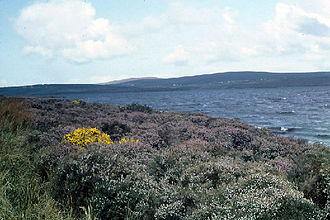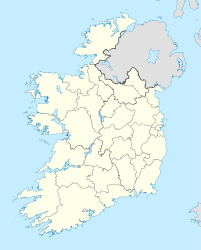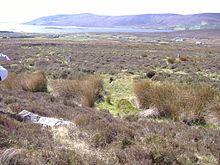- Carrowmore Lake
-
Carrowmore Lake
Loch na Ceathru MoireAm Westufer Geographische Lage County Mayo (Irland) Zuflüsse Carrowmore River Abfluss Owenmore River Inseln mehrere Daten Koordinaten 54° 0′ 0″ N, 9° 42′ 0″ W54-9.7Koordinaten: 54° 0′ 0″ N, 9° 42′ 0″ W Carrowmore Lake (irisch Loch na Ceathru Moire) ist ein See im County Mayo, Provinz Connacht in der Republik Irland. Der See liegt zwischen den Orten Bangor Erris und Barnatra am Südende der Broadhaven Bay der Irischen See.
Inhaltsverzeichnis
Allgemeines
Carrowmore Lake ist ein Süßwasser-See, hat einen Maximaldurchmesser von rund 5 km und ist von Bergland umgeben. Der See ist nicht sehr tief, liefert aber für die ganze Region Erris auf der Mullet-Halbinsel das Trinkwasser. Die Ufer sind von einem Moor-Gürtel umgeben, trotzdem gibt es eine nicht unerhebliche Anzahl von Wohnhäusern entlang der Moorgebiete. Das Wassereinzugsgebiet des Sees reicht bis in die Region von Kilcommon, wo sich die wichtige Corrib-Gas-Raffinerie befindet, die das natürliche Erdgasvorkommen vor der Küste fördert und verarbeitet.
Blick vom Norden mit zwei prähistorischen Menhiren in der Bildmitte
Ein Gedicht von George William Russell über den Carrowmore Lake[1] befindet sich im Archiv der National Library of Ireland.
Archäologie
Einige der Inseln im See sind crannogs (künstliche Inseln), die als Befestigungsanlagen von der Eisenzeit bis ins 17. Jahrhundert dienten. Das Bergfort Rathmorgan (Iorras Domhnann) auf einem Berg am Südwestufer des Carrowmore Lake soll die in der Sage Táin Bó Flidhais („Das Wegtreiben von Flidhais' Rindern“) genannte Burg Dún Flidhais sein.
Carrowmore Lake darf nicht mit dem ebenfalls archäologisch wichtigem Gebiet Carrowmore im County Sligo verwechselt werden.
Weblinks
Einzelnachweise
Kategorien:- County Mayo
- Archäologischer Fundplatz in Irland
- See in Irland
Wikimedia Foundation.



